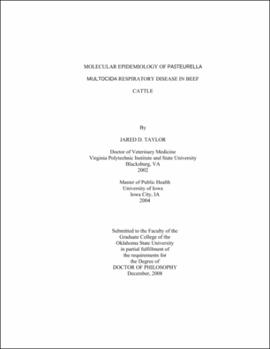| dc.contributor.advisor | Confer, Anthony W. | |
| dc.contributor.author | Taylor, Jared D. | |
| dc.date.accessioned | 2013-11-26T08:35:17Z | |
| dc.date.available | 2013-11-26T08:35:17Z | |
| dc.date.issued | 2008-12 | |
| dc.identifier.uri | https://hdl.handle.net/11244/7675 | |
| dc.description.abstract | Two studies were performed to investigate the epidemiology of P. multocida isolated from the respiratory tracts of cattle. The first study used 41 P. multocida isolates obtained from fatal cases of bovine respiratory disease (BRD). These isolates were subjected to random amplified polymorphic DNA polymerase chain reaction (RAPD PCR) fingerprinting using three different primers, as well as characterized through examination of whole cell proteins (WCP), outer membrane proteins (OMP) and serotyping. Simpson's index of diversity was used to assess the ability of the various typing methods to discriminate between strains. All typing methods were able to discern differences amongst the isolates, but cross-tabulation of typing results was needed to attain adequate discriminatory ability. Adjusted Rand and Wallace correlation coefficients found poor concordance between the groupings produced by the various typing techniques. | |
| dc.description.abstract | In the second study, the same primers were used as in the first study for RAPD PCR examination of 213 P. multocida isolates. These isolates were obtained from the upper respiratory tract of calves purchased from commercial salebarns and shipped to the Willard Sparks Beef Research Center. Nasal swabs were collected from all calves at time of arrival. Any calf that was diagnosed with clinical BRD was sampled again at time of treatment, as was a clinically health control calf. Little diversity was observed among the isolates, and no association was detected between typing results and treatment. However, significant associations were detected between typing results and arrival group and pen. These findings support the traditional hypothesis that P. multocida is an opportunistic pathogen, but provide evidence of horizontal transmission from colonized to naive cattle. Further research is warranted to confirm that strains obtained from the nares are indicative of strains associated with lower respiratory tract disease. | |
| dc.format | application/pdf | |
| dc.language | en_US | |
| dc.rights | Copyright is held by the author who has granted the Oklahoma State University Library the non-exclusive right to share this material in its institutional repository. Contact Digital Library Services at lib-dls@okstate.edu or 405-744-9161 for the permission policy on the use, reproduction or distribution of this material. | |
| dc.title | Molecular epidemiology of Pasteurella multocida respiratory disease in beef cattle | |
| dc.contributor.committeeMember | Dabo, Mady | |
| dc.contributor.committeeMember | Fulton, Robert W. | |
| dc.contributor.committeeMember | Krehbiel, Clinton R. | |
| dc.contributor.committeeMember | Lehenbauer, Terry W. | |
| osu.filename | Taylor_okstate_0664D_10027 | |
| osu.accesstype | Open Access | |
| dc.type.genre | Dissertation | |
| dc.type.material | Text | |
| dc.subject.keywords | bovine respiratory disease | |
| dc.subject.keywords | pasteurella multocida | |
| dc.subject.keywords | rapd pcr | |
| thesis.degree.discipline | Veterinary Biomedical Sciences | |
| thesis.degree.grantor | Oklahoma State University | |
